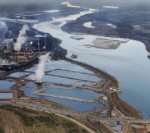 So disturbed by ruin of the region, Alberta’s Catholic bishop has written a lengthy letter arguing that the tar sands development “cannot be morally justified.”
So disturbed by ruin of the region, Alberta’s Catholic bishop has written a lengthy letter arguing that the tar sands development “cannot be morally justified.”
David Ebner, January 27, 2009, The Globe and Mail — The oil sands, hated by environmentalists and buffeted by plunging oil prices, now face the opposition of a representative of a higher power. Luc Bouchard, Roman Catholic bishop in the northeastern Alberta diocese of St. Paul, which includes the oil sands around Fort McMurray, said the rapid development and massive scale of the sprawling open-pit mines “cannot be morally justified.” “The tar sands are in my diocese, and we all have a responsibility,” Bishop Bouchard said in an interview yesterday. “If we are to manage creation, we have a responsibility in not destroying it but managing it well.”
Bishop Bouchard published his view in a 5,000-word essay, heavy with 50 footnotes, on Sunday – a pastoral letter to the 50,000 or so Catholics in his region. In his eight years as bishop of the diocese, he has written on topics including gambling and Catholic schooling. The detailed letter is unequivocal in its conclusion: Citing similar demands of environmentalists, the bishop calls for a halt to any new development, or leasing of land for potential development, until governments address 10 shortcomings. They include rules to slash national greenhouse-gas emissions, ambitious fuel-efficiency standards so oil is not wasted, and money for future reclamation of the land collected before a project is allowed to proceed. “The concerns environmentalists express are highly credible,” Bishop Bouchard wrote in his pastoral letter. “I am forced to conclude that the integrity of creation in the Athabasca oil sands is clearly being sacrificed for economic gain.”
The impact on local communities, mostly First Nation tribes like the Cree, is nothing short of appalling. Visiting a Cree village and speaking to one of its Elders, Nikiforuk writes, “MacDonald doesn’t have much faith that industry or government will reclaim the toxic ponds that surround his home. About 90 percent of the water withdrawn from the Athabasca River for mining ends up behind massive tailings dams or dikes…All these ponds contain polycyclic aromatic hydrocarbons (PAHs), naphthenic acids, heavy metals, salts, and bitumen.” The tailings are leaking into the Athabasca too, poisoning the indigenous fish that locals have long relied on for food.
In some heartbreaking interviews with tar sands activist MacDonald Stainsby, local residents reveal that cancer rates in their communities are up, wildlife is disappearing, and river levels are dropping constantly.
The local impact is under-covered, and more people should be able see for themselves how grave this social and ecological injustice is. Read Nikiforuk’s piece, or check out the absolutely astonishing 15-part VBS series “Toxic Alberta,” which covers the tar sands from every angle.
Oil sands mining is licensed to use twice the amount of fresh water that the entire city of Calgary uses in a year.
At least 90% of the fresh water used in the oil sands ends up in ends up in tailing ponds so toxic that propane cannons are used to keep ducks from landing.
Processing the oil sands uses enough natural gas in a day to heat 3 million homes.
The toxic tailing ponds are considered one of the largest human-made structures in the world.
The ponds span nearly 20 square miles and can be seen from space.
Producing a barrel of oil from the oil sands produces three times more greenhouse gas emissions than a barrel of conventional oil.